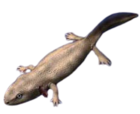Shirerpeton
Jump to navigation
Jump to search
| Shirerpeton Temporal range: Early Cretaceous,
| |
|---|---|

| |
| Reassembled skull seen from multiple angles and a line drawing of the skull | |
| Scientific classification | |
| Domain: | Eukaryota |
| Kingdom: | Animalia |
| Phylum: | Chordata |
| Class: | Amphibia |
| Order: | †Allocaudata |
| Family: | †Albanerpetontidae |
| Genus: | †Shirerpeton Masumoto & Evans, 2018 |
| Type species | |
| †Shirerpeton isajii Masumoto & Evans, 2018
| |
Shirerpeton is an extinct genus of albanerpetontid amphibian from the Early Cretaceous Kuwajima Formation, which is located in Japan.[1] The type species is Shirerpeton isajii, which was described by Masumoto & Evans in 2018.[2] Shirerpeton represents the first record of Albanerpetontidae in East Asia and the holotype is SBEI 2459, a small block bearing most of a disarticulated but associated skull with some postcranial elements present as well.[2]
Phylogeny
From Daza et al (2020):[3]
| |||||||||||||||||||||||||||||||
References
- ^ Fujita, M. (2003). "Geological age and correlation of the vertebrate-bearing horizons in the Tetori Group". Memoir of the Fukui Prefectural Dinosaur Museum. 2: 3–14.
- ^ a b Ryoko Matsumoto; Susan E. Evans (2018). "The first record of albanerpetontid amphibians (Amphibia: Albanerpetontidae) from East Asia". PLOS ONE. 13 (1): e0189767. Bibcode:2018PLoSO..1389767M. doi:10.1371/journal.pone.0189767. PMC 5752013. PMID 29298317.
- ^ Daza, Juan D.; Stanley, Edward L.; Bolet, Arnau; Bauer, Aaron M.; Arias, J. Salvador; Čerňanský, Andrej; Bevitt, Joseph J.; Wagner, Philipp; Evans, Susan E. (2020-11-06). "Enigmatic amphibians in mid-Cretaceous amber were chameleon-like ballistic feeders". Science. 370 (6517): 687–691. Bibcode:2020Sci...370..687D. doi:10.1126/science.abb6005. ISSN 0036-8075. PMID 33154135. S2CID 226254862.



